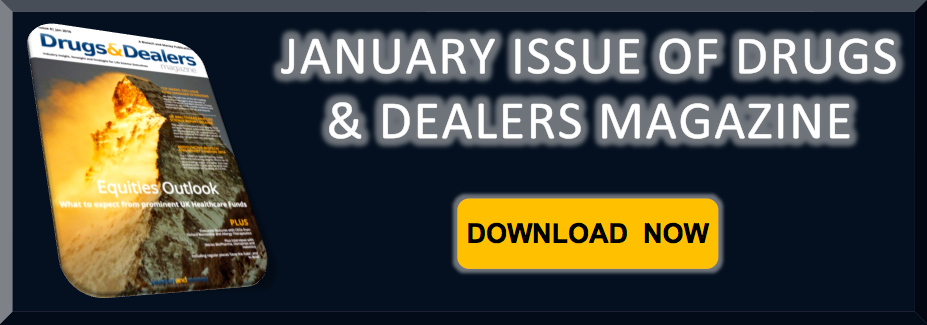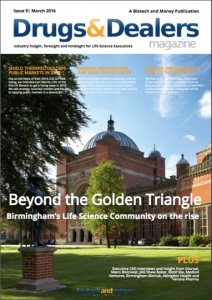Acquiring and developing a mid-stag portfolio
We recently spoke to Denise Scots-Knight of Mereo BioPharma about acquiring and developing a mid-stage portfolio. Denise is the Chief Executive Officer, a board member and co-founder of Mereo. Prior to Mereo, she led Phase4 Partners’ MBO from Nomura in 2010 becoming Phase4’s Managing Partner. Prior to becoming a venture capitalist she was in R&D management at Amersham and Fisons and a senior executive at Scientific Generics.
B&M: Denise, lets start by understanding the elevator pitch of your company? What does Mereo BioPharma do and what makes you different?
DSK: Mereo was founded to develop innovative medicines in speciality and rare diseases. What makes us different is that we are a development company. We look to bring in mid stage pipeline assets from pharmaceutical companies in a structure that allows them to retain some value from their pipeline without having to fund further development.
Despite being a company only founded in March, we already have two phase 2 programmes and a phase 3 programme, which we acquired from Novartis. We have been described as an upstart rather than a start-up, which I quite like.
B&M: What is it that you think the management team and the board bring to the strategy and approach you’ve taken with Mereo?
DSK: As you will be aware, Mereo’s history and heritage is that of Phase4 Ventures where we were very good at selecting products from earlystage development and actually seeing them through to market. So we’re very good at diligence and having that nose to pick the products that make it.
Another key skill is being able to identify and assemble the optimal team to deliver success. We have recently recruited the next layer of management who have extensive operational experience of clinical development.
The other thing is knowing how to finance a company. Not only do we have the investor contacts but we’ve been on the other side of the table so we know what investors look for.
Additionally we’re skilled in acquiring, selling and licencing products, plus structuring very detailed level negotiations and agreements.
As for our board members, they are a mix of people from large pharma companies, small biotech companies, public companies, private companies, so they bring a great deal of operating experience to the table.
B&M: In July you announced a substantial financing which was achieved with participation from the likes of Woodford Patient Capital and Invesco Perpetual. What do you feel drew the attention of such prominent investors?
DSK: I feel it was a combination of our great management team and the obvious experience that exists there, but also the acquisition of assets and our relationship with Novartis that was definitely a big tick in the box. It added a great deal of credibility. During the financing process Novartis made themselves available for diligence at a senior level. And that helped again add that credibility.
They also bought into the long term vision that we outlined. Not only did we have the three products we wanted to acquire, but we also told them what our plans were in terms of adding additional products down the line. Our goal is to get to 5 to 7 products. So our investors bought into that vision.
B&M: If we talk in more detail about the Novartis deal. I’m keen to get an understanding of what it is that attracted you to the 3 assets that you acquired. What made those 3 stand out?
DSK: If we start with BCT197 for AECOPD. We’re targeting treating acute exacerbations of COPD, not maintenance treatment for COPD. As we were looking at this programme, first of all we were attracted by the market, because it is in the acute exacerbations. If you look in that space there is very clearly an unmet medical need. What the patients receive right now, there’s been no new therapy in that area for years. Secondly as we looked at the data on BCT, what we saw was with a particular dosing regimen there was actually a significant increase in the FEV1 of these patients, above the standard of care they were receiving. It was impressive data.
So when combined with the ability to look at acute dosing of BCT197 in the acute exacerbation COPD setting in the hospital, it seemed to us like a very interesting market opportunity.
Our second programme is BGS649. BGS is for hypogonadotrophic hypogonadism, We call it HH. So this is basically inadequate levels of testosterone. This can occur for a number of reasons and there is a significant prevalence in men with a BMI of more than 30. It’s an aromatase inhibitor, so it targets essentially the fat cells.
We already have data that shows BCT increases the testosterone levels in this patient group in a statistically significant way. And importantly in the data we have already it has been shown that the drug doesn’t shoot testosterone to supra-physiological levels. So we’re looking now at doing a dose optimisation study in a Phase 2b.
In terms of looking at pricing and reimbursement, we’re adding some patient recorded outcomes, PRO’s, into our study. So that’s BGS.
The final product is our orphan disease product which is for brittle bone disease, BPS804. BPS is an antibody that targets sclerostin. Brittle bone disease effects in the US about 20,000-40,000 patients, while in Europe it’s 7.5 for every 100,000. Novartis already had Phase 2 data in patients. This showed a statistically significant effect on bone mass density, in a small group of patients. So this is a programme that we are taking directly into a Phase 3 registration study.
B&M: What is it that Novartis gains from this arrangement? What is it you set out with Novartis when you agreed the asset acquisition?
DSK: What was key was the alignment of vision and the shared attitude with respect to the risk reward profile. No upfront cash payment was required, rather Novartis saw the benefit of an equity stake in the development vehicle. Novartis does have an observer seat on the board, so they get to monitor the progress of the programmes as they go along. But there are no buy back rights on any of the programmes.
If we commercialise the programmes directly, so for example the orphan asset, they have a royalty on that product. If we out-licencing a programme they get a share of what we receive. And if we sell a programme there’s a pass through royalty as if we were commercialising. So there’s 3 different structures. Essentially they have a share of the downstream economics.
B&M: Do you see the approach you’re taking as a mainstream option for more companies to commercialise mid-stage assets?
DSK: At Phase4 we completed 3 spinouts from pharmaceutical companies. In these situations what you have is a Pharma company that strategically is saying, ok, we’re no longer going to invest in these assets. They may be good assets but strategically this is an area we’re not in.
But what we’re doing is obviously quite different. What we’re doing here is looking at pharma’s pipeline, and they’re prioritising programmes and we’re prioritising programmesside by side effectively.
Will it be possible to replicate it? Yes of course. In fact there are probably other examples out there already. There are companies that have done this with single products. We’ve taken a portfolio approach.
What’s important for Mereo is that we see a lot of deal flow from other pharma pipelines. So for us the key is to be able to identify other products, keep our hurdles in terms of selectivity, but have enough volume of deal flow that we can find other products.
I think this type of programme development will grow as it’s combined with the P&L pressure of Pharma, their therapeutic focus and the resources at hand.
B&M: What can we look forward to in the near term for any of those 3 programmes mentioned?
DSK: The key is moving all 3 programmes to the next clinic trial stage. That’s what we’re focussed on. Over the course of the first 6 months of next year, that’s the news flow. We are also actively looking at other programmes. Another key focus next year is going to be looking to add another product.
B&M: If we lead into the conversation about the ICON partnership- It leads on nicely from clinical milestones you want to put in place. Can we talk a little bit about how that partnership came about and what it is I guess you hope to achieve from that?
DSK: The ICON partnership came about when we were putting this together, in dilligencing and putting feasibility of clinical development plans together for those programmes. We realised we were 3 or 4 people putting this together. We had advisers helping us, but we realised as a group it would be good to have a CRO alongside those from the get go.
It was fantastic for us to have a resource like ICON available. Not only were they available, they worked at risk with us during that initial founding period, because we were funding a lot of the expenses every which way we could, in true entrepreneurial style.
They agreed to work with us at risk for a defined budget. That was a fantastic resource. It’s becoming more of a CRO company relationship, but it’s more integrated than normal. With the 3 programmes we have we are an important client for ICON if you look at the list of their clients.
ICON are obviously aware of our plans to add more products. The potential business stream for them is high, so they didn’t want equity. We didn’t discuss equity. It wasn’t something either of us entertained - because we didn’t want any conflicts - but working at risk was and CRO’s don’t often work at risk.
B&M: If I just come back to something you mentioned earlier, about the ability to add on more products later on down the line. Do you see that being solely with Novartis or are you agnostic as to where you might add on your portfolio?
DSK: We are looking at other programmes with Novartis, but we do also have deal flow from other companies. I think in an ideal world it will be a mixture of both.
B&M: What are the perceived challenges and bottlenecks you think you may come up against in achieving everything that we’ve discussed? What is it that might be keeping you awake at night?
DSK: The challenges will change. When we’re in the clinic it will probably change. We’ll be worried about all the standard things that development companies worry about, which is involvement, how are the studies going, is the data due on time? All the normal, I would say, systemic development company things that a CEO has to worry about.
Then as we add on new products we’re going to have to finance them at the time. That’s the way we’re developing the model. If we choose the right products hopefully that won’t become a limitation, but there’s always a risk there.
I had thought the recruitment side was going to be difficult. But because of our financing and our location and because of what we’ve done, I’m less concerned about that now.
B&M: A place to close the interview then would be to talk about level of ambition. What is that ambition you hold for Mereo.
DSK: We want to have ideally 5 to 7 programmes in development on a static basis. In the long term we may look to commercialise the orphan product. So the goal is to acquire more rare disease products, and look to commercialise those. Those are the long term goals. What we’re looking to do here is to build a real company.
My view is that you should always try to build a standalone company. If you do that, other opportunities may come along. But that’s what you should do. There’s no guarantee to be able to buy and sell assets. So that’s the other thing I think we’ll continue to do as well… Although we will focus on drugs for orphan and rare diseases, we’ll continue to look to diversify the portfolio in terms of the different risks with each of the programmes.
Denise Scots-Knigh is the Chief Executive Officer, a board member and co-founder of Mereo BioPharma. Prior to Mereo, she led Phase4 Partners’ MBO from Nomura in 2010 becoming Phase4’s Managing Partner. Prior to becoming a venture capitalist she was in R&D management at Amersham and Fisons and a senior executive at Scientific Generics.
Mereo BioPharma is a new UK-based speciality biopharmaceutical company focussed on the acquisition and rapid development of innovative medicines that have the potential to transform patient quality of life and improve human health. Mereo intends to optimise the commercial value of programmes by entering into partnering deals at key value inflection points or, for selected opportunities, commercialising products itself.





Leave a comment